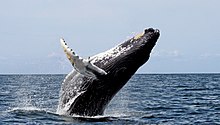Baleen whale
| Baleen whales Temporal range: late Eocene–Recent |
|
|---|---|
 |
|
| Humpback whale breaching | |
| Scientific classification | |
| Kingdom: | Animalia |
| Phylum: | Chordata |
| Class: | Mammalia |
| Order: | Artiodactyla |
| Infraorder: | Cetacea |
| Parvorder: |
Mysticeti Cope 1891 |
| Families | |
|
|
|
| Diversity | |
| 15 species | |
| Synonyms | |
|
|
Baleen whales (systematic name Mysticeti), known earlier as whalebone whales, form a parvorder of the infraorder Cetacea (whales, dolphins and porpoises). They are a widely distributed and diverse parvorder of carnivorous marine mammals. Mysticeti comprise the families Balaenidae (right whales), Balaenopteridae (rorquals), Cetotheriidae (the pygmy right whale), and Eschrichtiidae (the gray whale). There are currently 15 species of baleen whale. While cetaceans were historically thought to have descended from mesonychids, molecular evidence supports them as relatives of even-toed ungulates (Artiodactyla). Baleen whales split from toothed whales (Odontoceti) around 34 million years ago.
Baleen whales range in size from the 20 ft (6 m) and 6,600 lb (3,000 kg) pygmy right whale to the 112 ft (34 m) and 190 t (210 short tons) blue whale, which is also the largest creature on earth. They are sexually dimorphic. Baleen whales can have streamlined or large bodies, depending on the feeding behavior, and two limbs that are modified into flippers. Though not as flexible and agile as seals, baleen whales can swim very fast, with the fastest able to travel at 23 miles per hour (37 km/h). Baleen whales use their baleen plates to filter out food from the water by either lunge-feeding or skim-feeding. Baleen whales have fused neck vertebrae, and are unable to turn their head at all. Baleen whales have two blowholes. Some species are well adapted for diving to great depths. They have a layer of fat, or blubber, under the skin to keep warm in the cold water.
...
Wikipedia
